Indirect Induction Sintering of Metal Parts Produced through Material Extrusion Additive Manufacturing
Abstract
:1. Introduction
2. Materials and Methods
2.1. Sintering Parameters
- The geometries were buried in the Al2O3 refractory sintering ballast acquired from the Virtual Foundry (Stoughton, WI, USA), with a layer of ~2 cm sintering carbon pellets added on the top layer of the ballast. The test setup is shown in Figure 5, with the debinded geometry partially buried within the refractory ballast (Figure 5a), the carbon pellets and graphite crucible prepared (Figure 5b), the sintering treatment in operation (Figure 5c), and the overall illustration of the experiment depicted (Figure 5d). Different treatments were conducted, whereby the geometries were subjected to soak times of 10 s, 30 s, 1 min, and 4 min. The samples were subsequently allowed to cool to room temperature.
- 2.
- Separate sintering trials were performed under vacuum, whereby the debinded specimens were inserted inside a vacuum tube. The geometry was first placed on top of an alumina foam block acquired from MTIxl (Richmond, California, USA), subsequently encased in a high-purity graphite crucible acquired from the LLF Smelting Lab and inserted in the vacuum tube with the vacuum level maintained at 1.8 × 10−2 millibar. An illustration of the test setup is provided in Figure 6a, with the test sample on top of the foam block and encased by the crucible, as shown in Figure 6b, the vacuum assembly during operation (Figure 6c), and the sample being subjected to the treatment (Figure 6d). The vacuum sintering trials were conducted for hold times of 10 s, 30 s, 1 min, and 6 min, after which the specimens were left to cool to room temperature.
2.2. Microstructure and Atomic Composition Measurements
3. Results & Discussion
3.1. Sintering Kinetics & Porosities
3.2. Microstructure
3.3. Composition Analysis
3.4. Shrinkage and Surface Quality
4. Conclusions
- The capacity to sinter under vacuum conditions via pure thermal radiation can achieve bulk densities of up to 99.8% in only 6 min of soak time and densities of 99.9% in 4 min when sintered within a refractory ballast under an open atmosphere. The highly concentrated power densities of induction sintering result in the technology being highly efficient. The reported improvements in the sintering kinetics exceed those obtained with traditional state-of-the-art methods and underline a new significant advantage of combining local sintering during the manufacturing process, cutting the processing times of FFF parts. However, the sintering time depends on the volume of the geometry, whereby higher soaking times will be necessary for larger bodies.
- The average porosity size and ellipticity of sintered FFF parts can be reduced by increasing the soak time. When sintering is conducted under a vacuum for 120 s increased soak time, the average porosity size can be reduced by 80.92%.
- By tailoring the heating rates and transfer mechanism of the process, an isotropic FCC microstructure is possible. It is advisable that dedicated sintering profiles are developed in future work to ensure high densities while rendering small equiaxed, fine grains.
- The careful extraction of the fumes generated from the heating of a graphite crucible should be considered to mitigate the absorption of carbon residues by the metallic solid mass. Further studies should focus on using other types of crucibles.
- An improved surface roughness with a decrease of 43.32% can be achieved on samples sintered under a vacuum compared to the refractory ballast sintered samples. The correlation between the surface roughness and the shrinkage of dense sintered parts needs to be further investigated in future work.
5. Patents
Author Contributions
Funding
Institutional Review Board Statement
Informed Consent Statement
Data Availability Statement
Conflicts of Interest
References
- Najmon, J.C.; Raeidi, S.; Tovar, A. Review of additive manufacturing technologies and applications in the aerospace industry. In Additive Manufacturing for the Aerospace Industry; Elsevier: Amsterdam, The Netherlands, 2019; pp. 7–31. [Google Scholar] [CrossRef]
- Blakey-Milner, B.; Gradl, P.; Snedden, G.; Brooks, M.; Pitot, J.; Lopez, E.; Leary, M.; Berto, F.; du Plessis, A. Metal additive manufacturing in aerospace: A review. Mater. Des. 2021, 209, 110008. [Google Scholar] [CrossRef]
- Vasco, J.C. Additive manufacturing for the automotive industry. In Additive Manufacturing: Handbooks in Advanced Manufacturing; Pou, J., Riveiro, A., Davim, J.P., Eds.; Elsevier: Amsterdam, The Netherlands, 2021; pp. 505–530. [Google Scholar] [CrossRef]
- Charles, A.; Hofer, A.; Elkaseer, A.; Scholz, S.G. Additive manufacturing in the automotive industry and the potential for driving the green and electric transition. In Proceedings of the International Conference on Sustainable Design and Manufacturing, Split, Croatia, 15–17 September 2021. [Google Scholar] [CrossRef]
- Kumar, R.; Kumar, M.; Chohan, J.S. The role of additive manufacturing for biomedical applications: A critical review. J. Manuf. Proc. 2021, 64, 828–850. [Google Scholar] [CrossRef]
- Sheoran, A.J.; Arora, H.K.P.K.; Moona, G. Bio-medical applications of Additive Manufacturing: A Review. Procedia Manuf. 2020, 51, 663–670. [Google Scholar] [CrossRef]
- Sun, C.; Wang, Y.; McMurtrey, M.D.; Jerred, N.D.; Liou, F.; Li, J. Additive manufacturing for energy: A review. Appl. Energy 2021, 282, 116041. [Google Scholar] [CrossRef]
- Linke, S.; Voß, A.; Ernst, M.; Taschner, P.A.; Baasch, J.; Stapperfend, S.; Gerdes, N.; Koch, J.; Weßels, P.; Neumann, J.; et al. Two-dimensional laser melting of lunar regolith simulant using the MOONRISE payload on a mobile manipulator. 3D Print. Addit. Manuf. 2022, 9, 323. [Google Scholar] [CrossRef]
- Bhatia, A.; Sehgal, A.K. Additive manufacturing materials, methods and applications: A review. Mater. Today Proc. 2021; in press. [Google Scholar] [CrossRef]
- Ladani, L.; Sadeghilaridjani, M. Review of powder bed fusion additive manufacturing for metals. Metals 2021, 11, 1391. [Google Scholar] [CrossRef]
- Singh, D.D.; Mahender, T.; Reddy, A.R. Powder bed fusion process: A brief review. Mater. Today Proc. 2021, 46, 350–355. [Google Scholar] [CrossRef]
- Narasimharaju, S.R.; Zeng, W.; See, T.L.; Zhu, Z.; Scott, P.; Jiang, X.; Lou, S. A comprehensive review on laser powder bed fusion of steels: Processing, microstructure, defects and control methods, mechanical properties, current challenges and future trends. J. Manuf. Proc. 2022, 75, 375–414. [Google Scholar] [CrossRef]
- Sibisi, P.N.; Popoola, A.P.I.; Arthur, N.K.K.; Pityana, S.L. Review on direct metal laser deposition manufacturing technology for the Ti-6Al-4V alloy. Int. J. Adv. Manuf. Technol. 2020, 107, 1163–1178. [Google Scholar] [CrossRef]
- Li, Y.; Su, C.; Zhu, J. Comprehensive review of wire arc additive manufacturing: Hardware system, physical process, monitoring, property characterization, application and future prospects. Results Eng. 2022, 13, 100330. [Google Scholar] [CrossRef]
- Abbott, A.C.; Tandon, G.P.; Bradford, R.L.; Koerner, H.; Baur, J.W. Process-structure-property effects on ABS bond strength in fused filament fabrication. Addit. Manuf. 2018, 19, 29–38. [Google Scholar] [CrossRef]
- Gomez-Gras, G.; Jerez-Mesa, R.; Travieso-Rodriguez, J.A.; Lluma-Fuentes, J. Fatigue performance of fused filament fabrication PLA specimens. Mater. Des. 2018, 140, 278–285. [Google Scholar] [CrossRef] [Green Version]
- Arifvianto, B.; Iman, T.N.; Prayoga, B.T.; Dharmastiti, R.; Salim, U.A.; Mahardika, M.; Suyitno. Tensile properties of the FFF-processed thermoplastic polyurethane (TPU) elastomer. Int. J. Adv. Manuf. Technol. 2021, 117, 1709–1719. [Google Scholar] [CrossRef]
- Terekhina, S.; Skornyakov, I.; Tarasova, T.; Egorov, S. Effects of the Infill Density on the Mechanical Properties of Nylon Specimens Made by Filament Fused Fabrication. Technologies 2019, 7, 57. [Google Scholar] [CrossRef] [Green Version]
- Zanjanijam, A.R.; Major, I.; Lyons, J.G.; Lafont, U.; Devine, D.M. Fused Filament Fabrication of PEEK: A Review of Process-Structure-Property Relationships. Polymers 2020, 12, 1665. [Google Scholar] [CrossRef] [PubMed]
- Forés-Garriga, A.; Pérez, M.A.; Gómez-Gras, G.; Reyes-Pozo, G. Role of infill parameters on the mechanical performance and weight reduction of PEI Ultem processed by FFF. Mater. Des. 2020, 193, 108810. [Google Scholar] [CrossRef]
- Çevik, Ü.; Kam, M. A Review Study on Mechanical Properties of Obtained Products by FDM Method and Metal/Polymer Composite Filament Production. J. Nanomater. 2020, 2020, 6187149. [Google Scholar] [CrossRef]
- İpekçi, A.; Ekici, B. Experimental and statistical analysis of robotic 3D printing process parameters for continuous fiber reinforced composites. J. Compos. Mater. 2021, 55, 2645–2655. [Google Scholar] [CrossRef]
- Zaccardi, F.; Toto, E.; Santonicola, M.G.; Laurenzi, S. 3D printing of radiation shielding polyethylene composites filled with Martian regolith simulant using fused filament fabrication. Acta Astronaut. 2022, 190, 1–13. [Google Scholar] [CrossRef]
- Scheithauer, U.; Weingarten, S.; Johne, R.; Schwarzer, E.; Abel, J.; Richter, H.-J.; Moritz, T.; Michaelis, A. Ceramic-Based 4D Components: Additive Manufacturing (AM) of Ceramic-Based Functionally Graded Materials (FGM) by Thermoplastic 3D Printing (T3DP). Materials 2017, 10, 1368. [Google Scholar] [CrossRef] [Green Version]
- Gonzalez-Gutierrez, J.; Cano, S.; Schuschnigg, S.; Kukla, C.; Sapkota, J.; Holzer, C. Additive manufacturing of metallic and ceramic components by the material extrusion of highly-filled polymers: A review and future perspectives. Materials 2018, 11, 840. [Google Scholar] [CrossRef] [PubMed] [Green Version]
- Gonzalez-Gutierrez, J.; Duretek, I.; Kukla, C.; Poljšak, A.; Bek, M.; Emri, I.; Holzer, C. Models to predict the viscosity of metal injection molding feedstock materials as function of their formulation. Metals 2016, 6, 129. [Google Scholar] [CrossRef] [Green Version]
- Hamidi, M.F.F.A.; Harun, W.S.W.; Khalil, N.Z.; Ghani, S.A.C.; Azir, M.Z. Study of solvent debinding parameters for metal injection moulded 316L stainless steel. IOP Conf. Ser. Mater. Sci. Eng 2017, 257, 012035. [Google Scholar] [CrossRef]
- Li, H.; Liu, Y.; Liu, Y.; Hu, K.; Lu, Z.; Liang, J. Effects of solvent debinding on the microstructure and properties of 3D-printed alumina ceramics. ACS Omega 2020, 42, 27455–27462. [Google Scholar] [CrossRef]
- Krug, S.; Evans, J.R.G.; ter Maat, J.H.H. Reaction and transport kinetics for depolymerization within a porous body. AlChE J. 2002, 48, 1533–1541. [Google Scholar] [CrossRef]
- Enneti, R.K.; Park, S.J.; German, R.M.; Atre, S.V. Review: Thermal debinding process in particulate materials processing. Mater. Manuf. Proc. 2012, 27, 103–118. [Google Scholar] [CrossRef]
- Lavecchia, F.; Pellegrini, A.; Galantucci, L.M. Comparative study on the properties of 17–4 PH stainless steel parts made by metal fused filament fabrication process and atomic diffusion additive manufacturing. Rapid Prototyp. J. 2022; ahead of print. [Google Scholar] [CrossRef]
- Thompson, Y.; Zissel, K.; Förner, A.; Gonzalez-Gutierrez, J.; Kukla, C.; Neumeier, S.; Felfer, P. Metal fused filament fabrication of the nickel-base superalloy IN 718. J. Mater. Sci. 2022, 57, 9541–9555. [Google Scholar] [CrossRef]
- Singh, P.; Balla, V.K.; Gokce, A.; Atre, S.V.; Kate, K.H. Additive manufacturing of Ti-6Al-4V alloy by metal fused filament fabrication (MF3): Producing parts comparable to that of metal injection molding. Prog. Addit. Manuf. 2021, 6, 593–606. [Google Scholar] [CrossRef]
- Redondo, E.; Pumera, M. Fully metallic copper 3D-printed electrodes via sintering for electrocatalytic biosensing. App. Mat. Today 2021, 25, 101253. [Google Scholar] [CrossRef]
- Myers, N.; Heaney, D. Metal injection molding (MIM) of high-speed tool steels: Sintering. In Handbook of Metal Injection Molding; Heaney, D.F., Ed.; Woodhead Publishing: Sawston, UK, 2012; pp. 516–525. [Google Scholar] [CrossRef]
- Oghbaei, M.; Mirzaee, O. Microwave versus conventional sintering: A review of fundamentals, advantages and applications. J. Alloy. Comp. 2010, 494, 175–189. [Google Scholar] [CrossRef]
- Ramesh, S.; Zulkifli, N.; Tan, C.; Wong, Y.; Tarlochan, F.; Ramesh, S.; Teng, W.; Sopyan, I.; Bang, L.; Sarhan, A.A. Comparison between microwave and conventional sintering on the properties and microstructural evolution of tetragonal zirconia. Ceram. Int. 2018, 44, 8922–8927. [Google Scholar] [CrossRef]
- Kessel, H.U.; Hennicke, J.; Schmidt, J.; Weißgärber, T.; Kieback, B.F.; Herrmann, M.; Räthel, J. "FAST" field assisted sintering technology- a new process for the production of metallic and ceramic sintering materials. Pulvermetall. Wiss. Und Prax. 2011, 22, 201–237. [Google Scholar]
- Raynova, S.; Collas, Y.; Yang, F.; Bolzoni, L. Advancement in the Pressureless Sintering of CP Titanium Using High-Frequency Induction Heating. Metall. Mater. Trans. A 2019, 50, 4732–4742. [Google Scholar] [CrossRef] [Green Version]
- Cavdar, U.; Atik, E. Induction Sintering of %3 Cu Contented Iron Based Powder Metal Parts. J. Modern Appl. Sci. 2010, 4, 63–70. [Google Scholar] [CrossRef] [Green Version]
- Guyon, A.; Bouvard, D.; Chaix, J.M.; Carry, C.P. Densification and microstructure changes of micron size nickel powder during direct induction sintering. Powder Metall. 2013, 57, 54–60. [Google Scholar] [CrossRef]
- Youn, S.W.; Kang, C.G. Fabrication of foamable precursors by powder compression and induction heating process. Metall. Mater. Trans. B 2004, 35, 769–776. [Google Scholar] [CrossRef]
- Shekari, M.; Adeli, M.; Khobzi, A.; Kobashi, M.; Kanetake, N. Induction-activated self-propagating, high-temperature synthesis of nickel aluminide. Adv. Powder Technol. 2017, 28, 2974–2979. [Google Scholar] [CrossRef]
- Olevsky, E.; Dudina, D. Induction Heating Sintering. In Field-Assisted Sintering; Springer: Cham, Switzerland, 2018; pp. 275–291. [Google Scholar] [CrossRef]
- Hassun, H.K.; Hussein, B.H.; al-Maiyaly, B.K. Modeling the effect of particle packing density for sintering. J. Phys. Conf. Ser. 2021, 1879, 032080. [Google Scholar] [CrossRef]
- Kong, X.; Barriere, T.; Gelin, J. Determination of critical and optimal powder loadings for 316L fine stainless steel feedstocks for micro-powder injection molding. J. Mat. Proc. Technol. 2012, 212, 2173–2182. [Google Scholar] [CrossRef]
- Beran, T.; Mulholland, T.; Henning, F.; Rudolph, N.; Oswald, T.A. Nozzle clogging factors during fused filament fabrication of spherical particle filled polymers. Addit. Manuf. 2018, 23, 206–214. [Google Scholar] [CrossRef]
- Ortega Varela de Seijas, M. Method and Apparatus for In Situ Debinding and Sintering of Filament or Paste Extrusion Additive Manufactured Metal or Ceramic Parts. Patent EP 21192364.4, 20 August 2021. [Google Scholar]
- German, R.M. Sintering Theory and Practice; Wiley: Hoboken, NJ, USA, 1996. [Google Scholar]
- German, R.M. Sintering: From Empirical Observations to Scientific Principles; Elsevier: Amsterdam, The Netherlands, 2014. [Google Scholar]
- Choi, H.W.; Kim, Y.H.; Rim, Y.H.; Yang, Y.S. Crystallization kinetics of lithium niobate glass: Determination of the Johnson–Mehl–Avrami–Kolmogorov parameters. Phys. Chem. 2013, 15, 9940–9946. [Google Scholar] [CrossRef] [PubMed]
- Wagner, A.M.; Engel, J.; Hadian, A.; Clemens, F.; Rodriguez-Arbaizar, M.; Carreño-Morelli, E.; Wheeler, J.; Spolenak, R. Filament extrusion-based additive manufacturing of 316L stainless steel: Effects of sintering conditions on the microstructure and mechanical properties. Addit. Manuf. 2022, 59, 103147. [Google Scholar] [CrossRef]
- Caminero, M.A.; Romero, A.; Chacón, J.M.; Núñez, P.J.; García-Plaza, E.; Rodríguez, G.P. Additive manufacturing of 316L stainless-steel structures using fused filament fabrication technology: Mechanical and geometric properties. Rapid Prototyp. J. 2021, 27, 583–591. [Google Scholar] [CrossRef]
- Thompson, Y.; Gonzalez-Gutierrez, C.K.J.; Felfer, P. Fused filament fabrication, debinding and sintering as a low cost additive manufacturing method of 316L stainless steel. Addit. Manuf. 2019, 30, 100861. [Google Scholar] [CrossRef]
- Rosnitschek, T.; Seefeldt, A.; Alber-Laukant, B.; Neumeyer, T.; Altstädt, V.; Tremmel, S. Correlations of geometry and infill degree of extrusion additively manufactured 316L stainless steel components. Materials 2021, 12, 5173. [Google Scholar] [CrossRef]
- Kalentics, N.; Ortega-Varela de Seijas, M.; Griffiths, S.; Leinenbach, C.; Logé, R. 3D laser shock peening—A new method for improving fatigue properties of selective laser melted parts. Addit. Manuf. 2020, 33, 101112. [Google Scholar] [CrossRef]
- Toda, H.; Masuda, S.; Batres, R.; Kobayashi, M.; Aoyama, S.; Onodera, M.; Furusawa, R.; Uesugi, K.; Takeuchi, A.; Suzuki, Y. Statistical assessment of fatigue crack initiation from sub-surface hydrogen micropores in high-quality die-cast aluminum. Acta Mater. 2011, 59, 4990–4998. [Google Scholar] [CrossRef]
- Carter, C.B.; Norton, M.G. Sintering and Grain Growth. In Ceramic Materials; Springer: New York, NY, USA, 2007; pp. 427–2243. [Google Scholar] [CrossRef]
- Sadaf, M.; Bragaglia, M.; Nanni, F. A simple route for additive manufacturing of 316L stainless steel via fused filament fabrication. J. Manuf. Proc. 2021, 67, 141–150. [Google Scholar] [CrossRef]
- Smallman, R.E.; Ngan, A. Annealing Twins. In Physical Metallurgy and Advanced Materials, 7th ed.; Elsevier: Amsterdam, The Netherlands, 2011; pp. 358–360. [Google Scholar]
- Sun, Z.; Tan, X.; Tor, S.B.; Chua, C.K. Simultaneously enhanced strength and ductility for 3D-printed stainless steel 316L by selective laser melting. NPG Asia Mater. 2018, 10, 127–136. [Google Scholar] [CrossRef] [Green Version]
- Tang, S.; Backofen, R.; Wang, J.; Zhou, Y.; Voigt, A.; Yu, Y.-M. Three-dimensional phase-field crystal modeling of fcc and bcc dendritic crystal growth. J. Cryst. Growth 2011, 334, 146–152. [Google Scholar] [CrossRef]
- Tsutsumi, Y.; Ishimoto, T.; Oishi, T.; Manaka, T.; Chen, P.; Ashida, M.; Doi, K.; Katayama, H.; Hanawa, T.; Nakano, T. Crystallographic texture- and grain boundary density-independent improvement of corrosion resistance in austenitic 316L stainless steel fabricated via laser powder bed fusion. Addit. Manuf. 2021, 45, 102066. [Google Scholar] [CrossRef]
- Karimi, P.; Ålgård, E.S.J.; Olsson, J.; Colliander, M.H.; Harlin, P.; Toyserkani, E.; Andersson, J. Tailored grain morphology via a unique melting strategy in electron beam-powder bed fusion. Mater. Sci. Eng. 2021, 824, 141820. [Google Scholar] [CrossRef]
- Santamaria, R.; Salasi, M.; Bakhtiari, S.; Leadbeater, G.; Iannuzzi, M.; Quadir, M.Z. Microstructure and mechanical behaviour of 316L stainless steel produced using sinter-based extrusion additive manufacturing. J. Mater. Sci. 2022, 57, 9646–9662. [Google Scholar] [CrossRef]
- Kurzynowski, T.; Gruber, K.; Stopyra, W.; Kuznicka, B.; Chlebus, E. Correlation between process parameters, microstructure and properties of 316 L stainless steel processed by selective laser melting. Mater. Sci. Eng. 2018, 718, 64–73. [Google Scholar] [CrossRef]
- Zhou, C.; Wang, J.; Hu, S.; Tao, H.; Fang, B.; Li, L.; Zheng, J.; Zhang, L. Enhanced corrosion resistance of additively manufactured 316L stainless steel after heat treatment. J. Electrochem. Soc. 2020, 167, 141504. [Google Scholar] [CrossRef]
- Riabov, D.; Leicht, A.; Ahlström, K.; Hryha, E. Investigation of the strengthening mechanism in 316L stainless steel produced with laser powder bed fusion. Mater. Sci. Eng. 2021, 822, 141699. [Google Scholar] [CrossRef]
- Atanda, P.; Fatudimu, A.; Oluwole, O. Sensitisation Study of Normalized 316L Stainless Steel. J. Miner. Mater. Charact. Eng. 2010, 9, 13–23. [Google Scholar] [CrossRef]
- Amin, A.M.; Ibrahim, M.H.I.; Asmawi, R.; Mustaffa, N.; Hashim, M.Y. Thermal debinding and sintering of water atomised SS316L metal injection moulding process. IOP Conf. Ser. Mater. Sci. Eng. 2017, 226, 012155. [Google Scholar] [CrossRef]
- Quarto, M.; Carminati, M.; D’Urso, G. Density and shrinkage evaluation of AISI 316L parts printed via FDM process. Mater. Manuf. Proc. 2021, 36, 1535–1543. [Google Scholar] [CrossRef]
- Gong, H.; Crater, C.; Ordonez, A.; Ward, C.; Waller, M.; Ginn, C. Material properties and shrinkage of 3D printing parts using Ultrafuse stainless steel 316LX filament. In Proceedings of the 5th International Conference on Mechanical, Materials and Manufacturing (ICMMM), Orlando, FL, USA, 13–15 December 2018. [Google Scholar] [CrossRef]
- Obadimu, S.O.; Kourousis, K.I. Shrinkage behaviour of material extrusion steel 316L: Influence of primary 3D printing parameters. J. Rapid Prototyp. 2022, 28, 92–101. [Google Scholar] [CrossRef]
- Banerjee, S.; Joens, C.J. Debinding and sintering of metal injection molding (MIM) components. In Handbook of Metal Injection Molding; Heaney, D.F., Ed.; Woodhead Publishing: Sawston, UK, 2012; pp. 133–180. [Google Scholar] [CrossRef]
- Ait-Mansour, I.; Kretzschmar, N.; Chekurov, S.; Salmi, M.; Rech, J. Design-dependent shrinkage compensation modeling and mechanical property targeting of metal FFF. Prog. Addit. Manuf. 2020, 5, 51–57. [Google Scholar] [CrossRef]





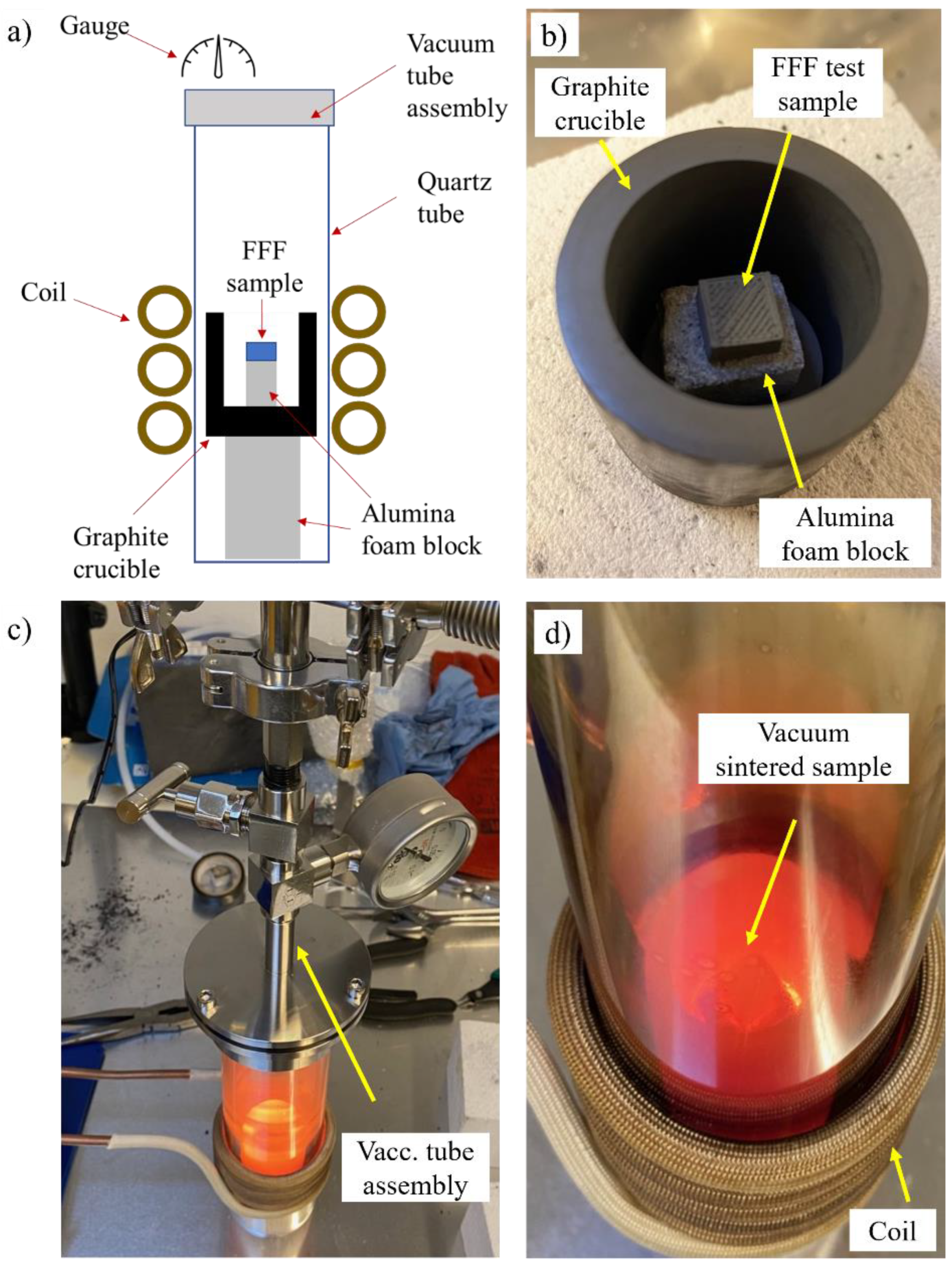
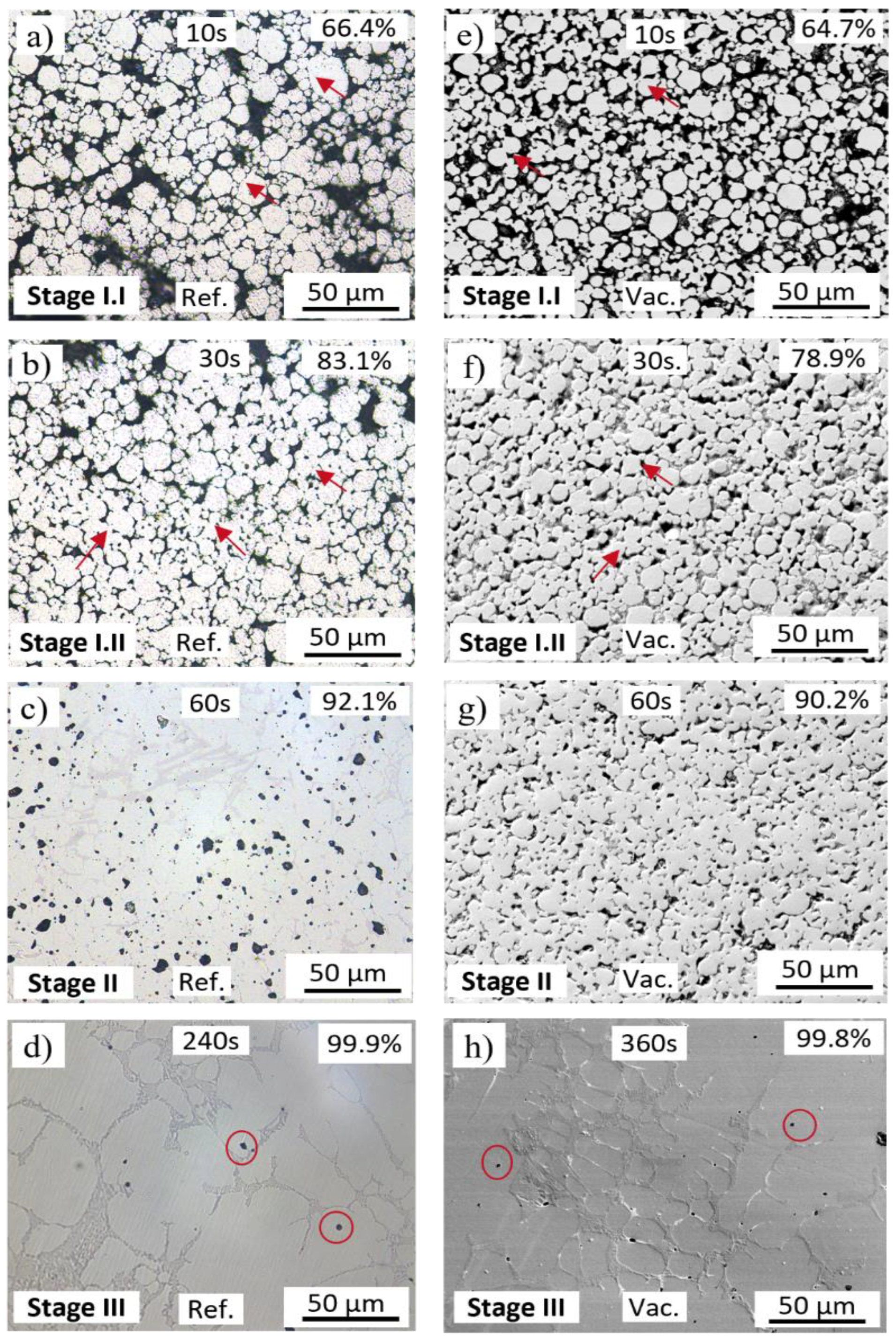
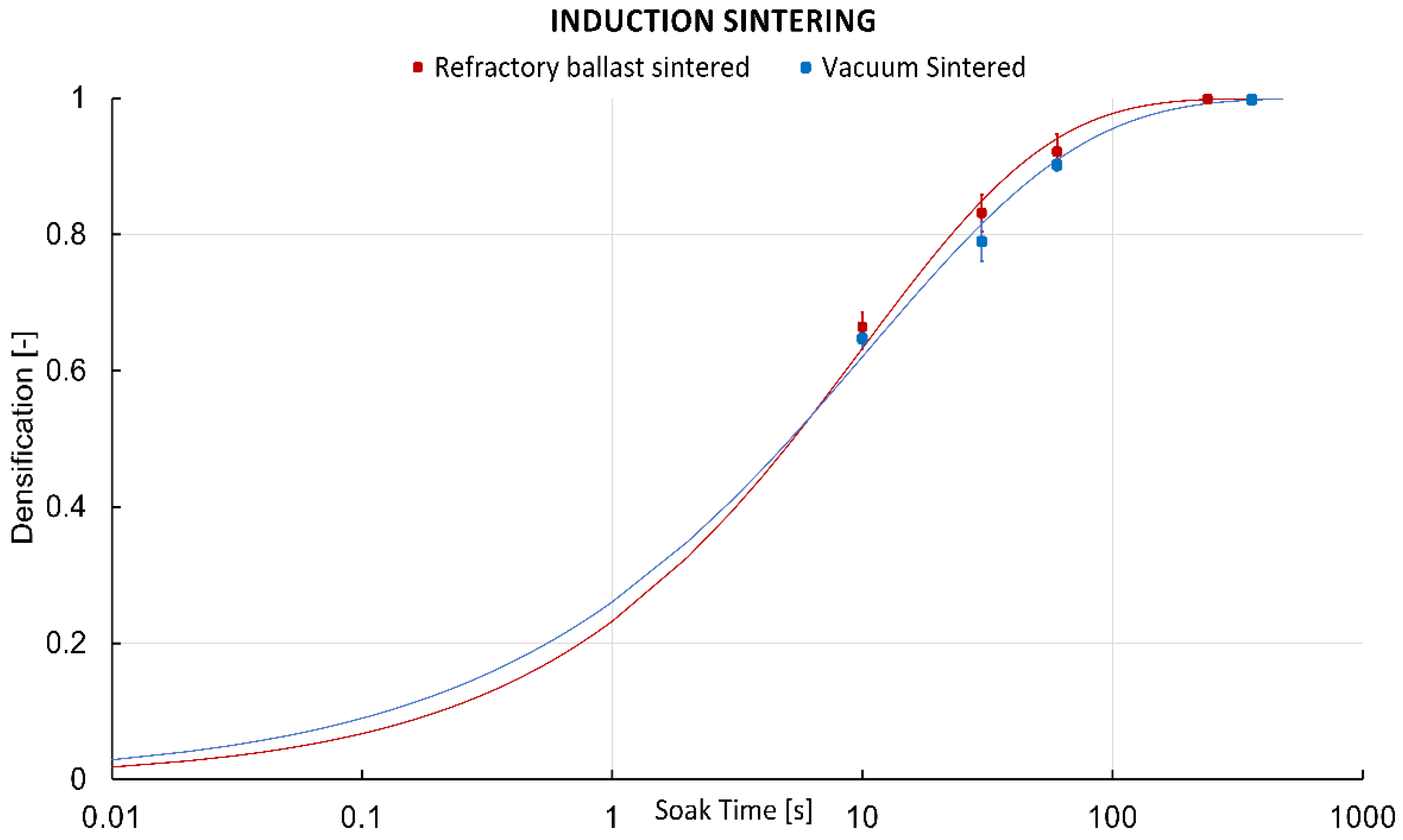
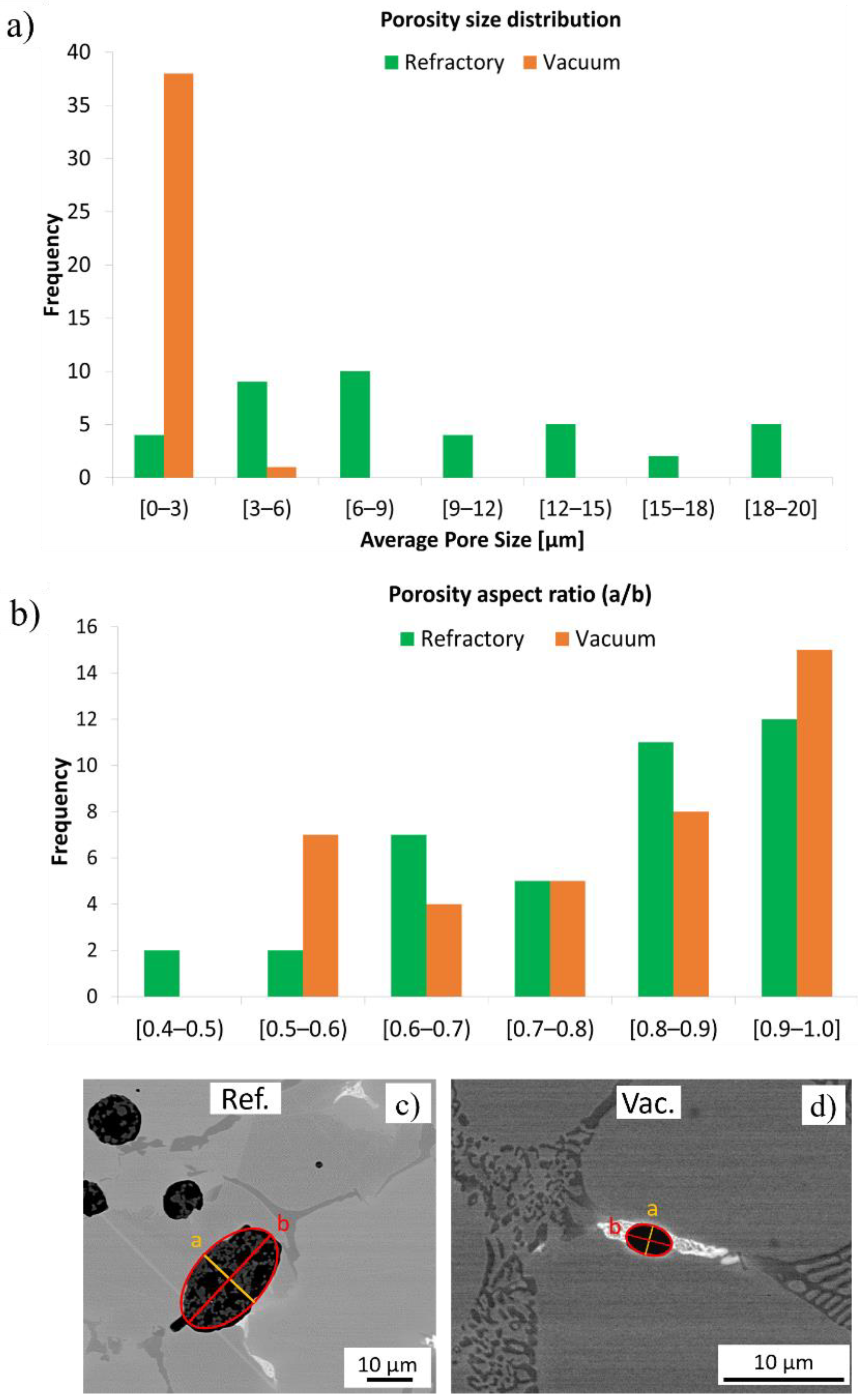
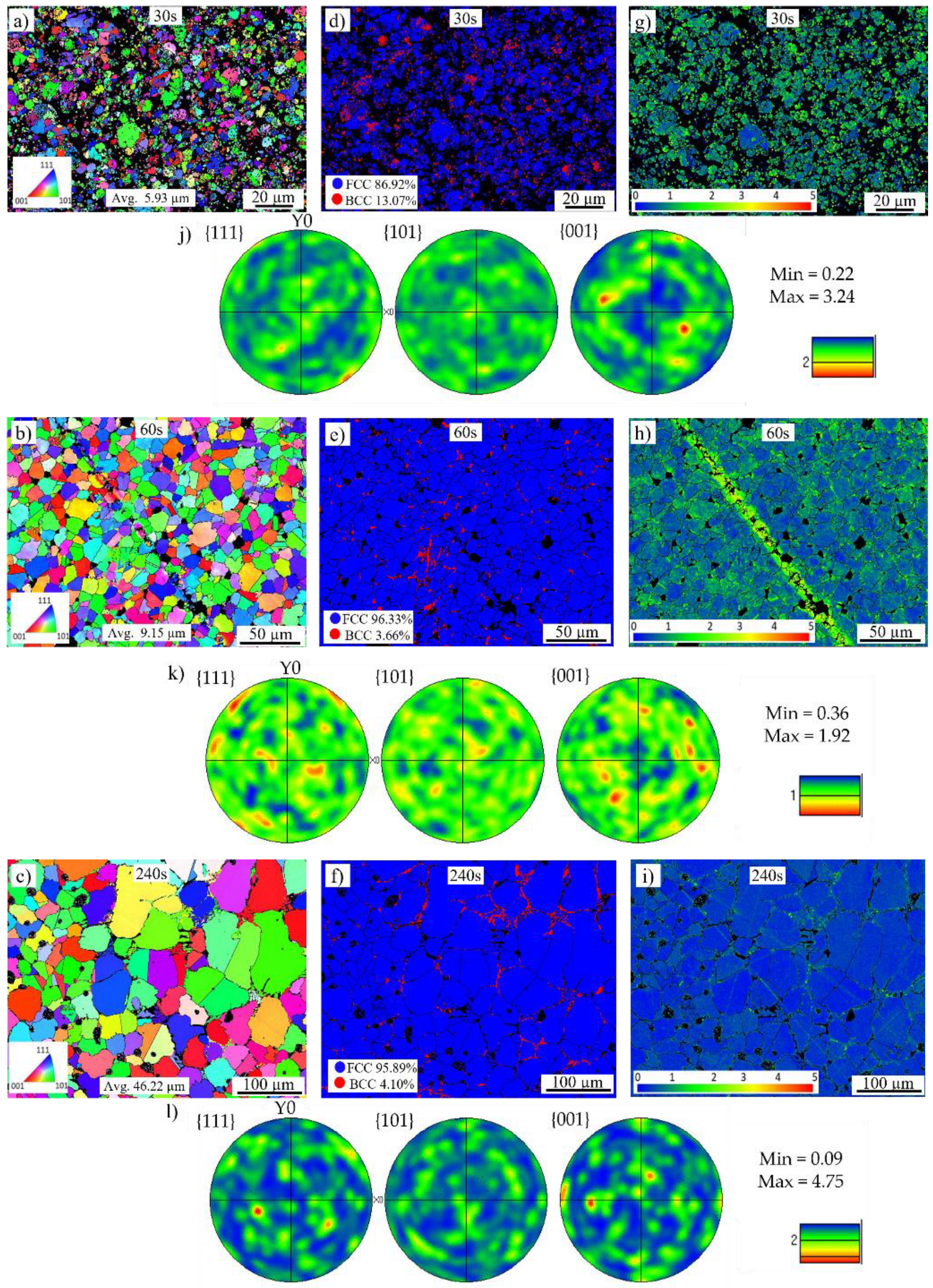
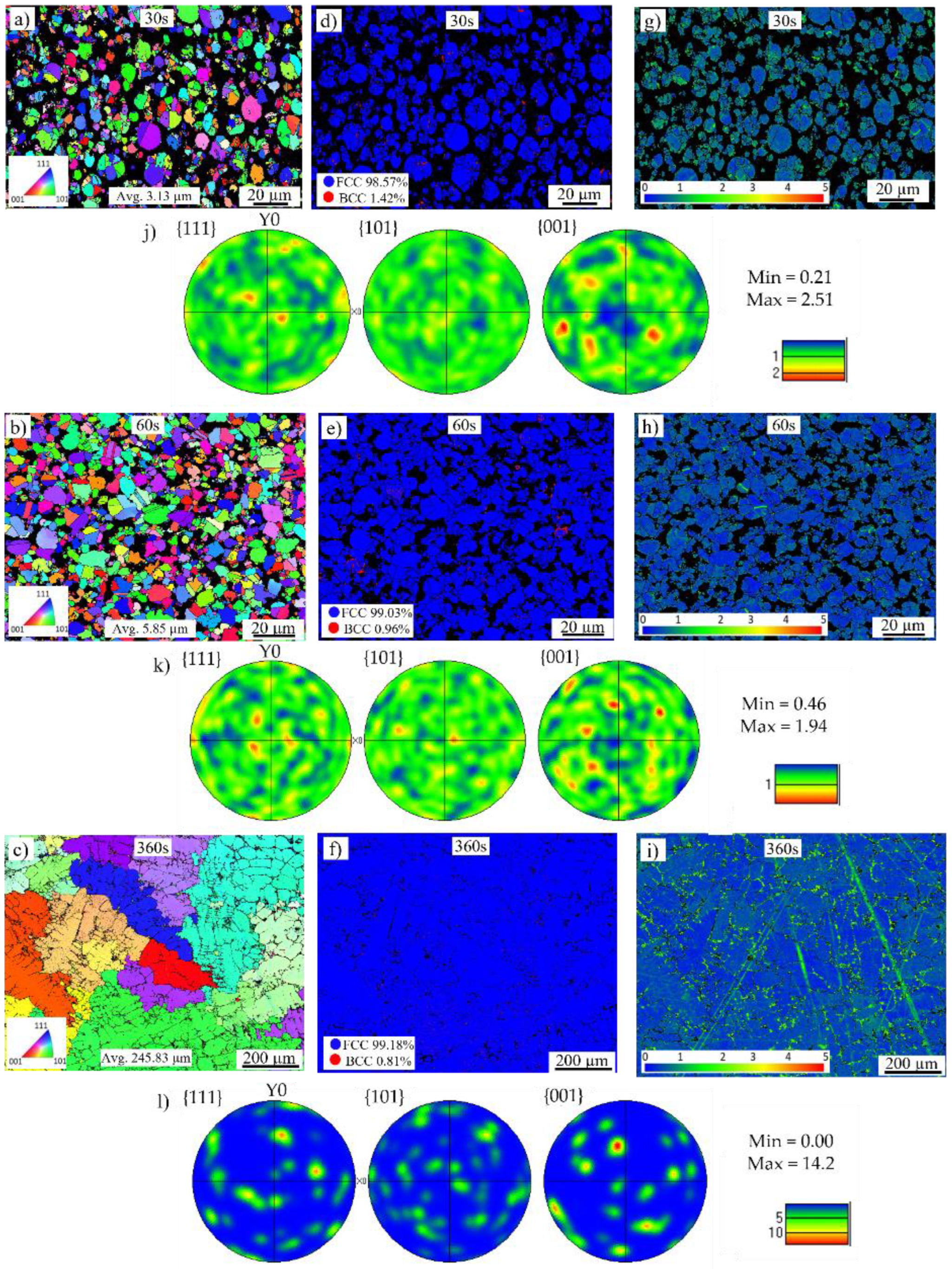
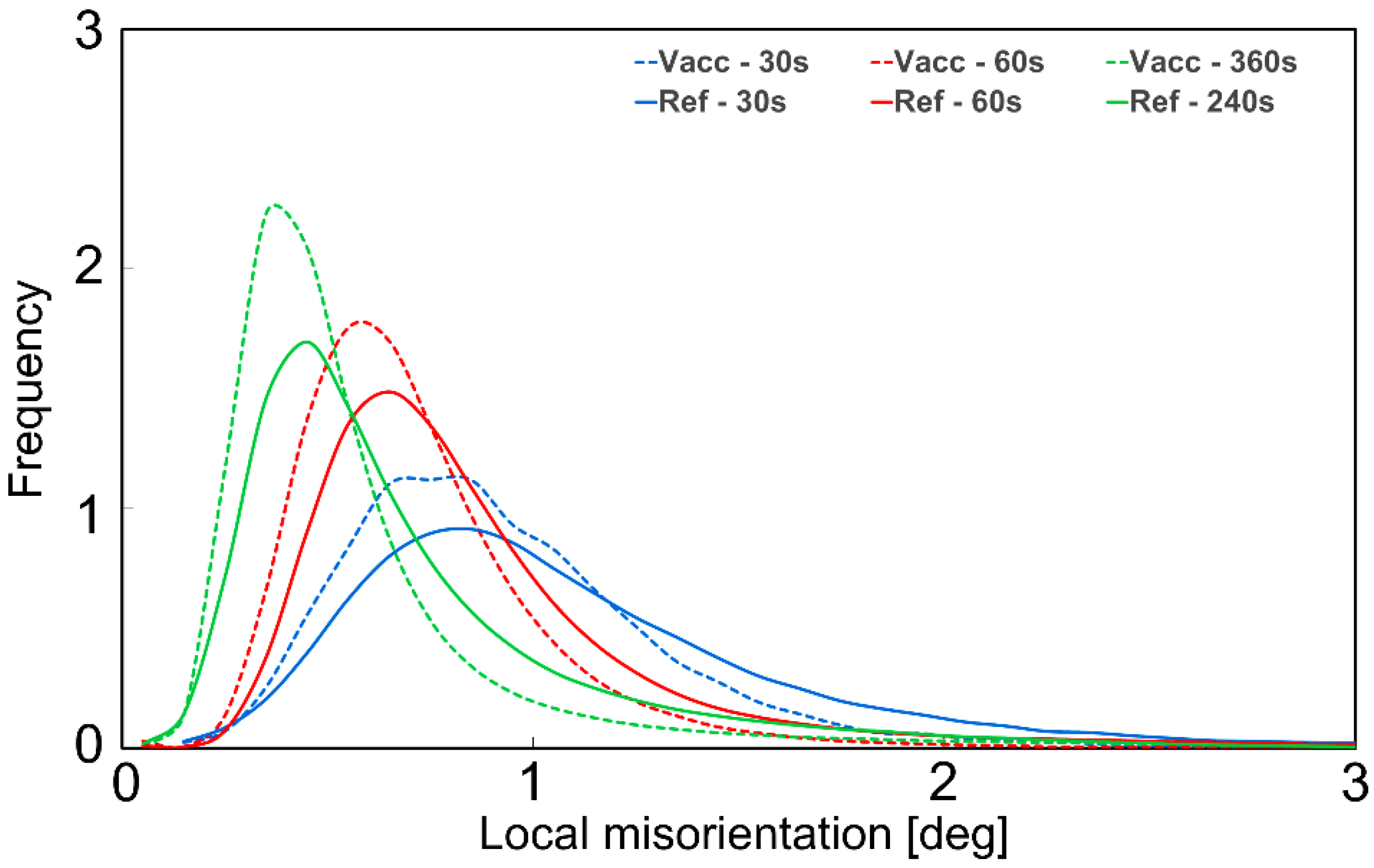




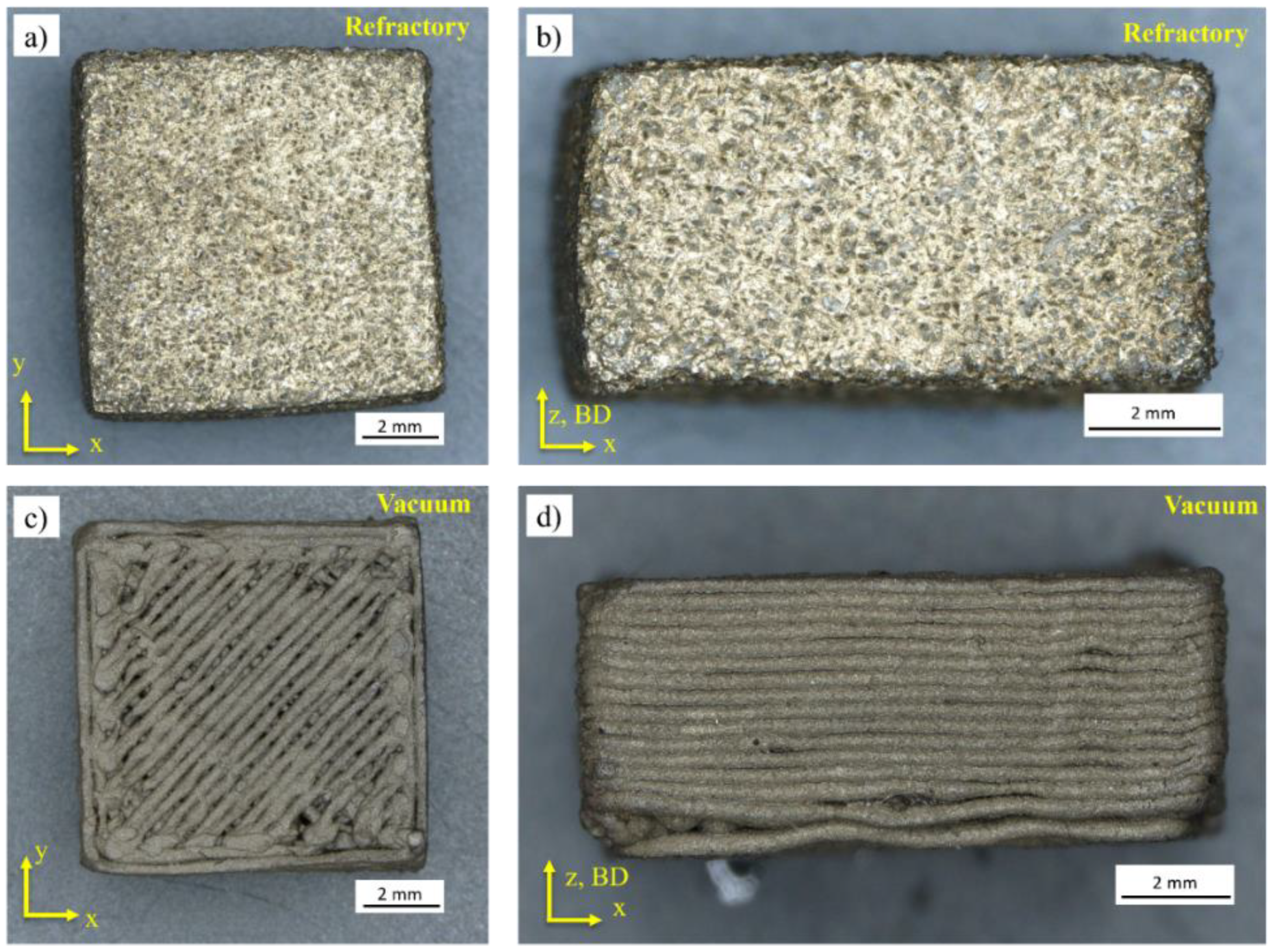
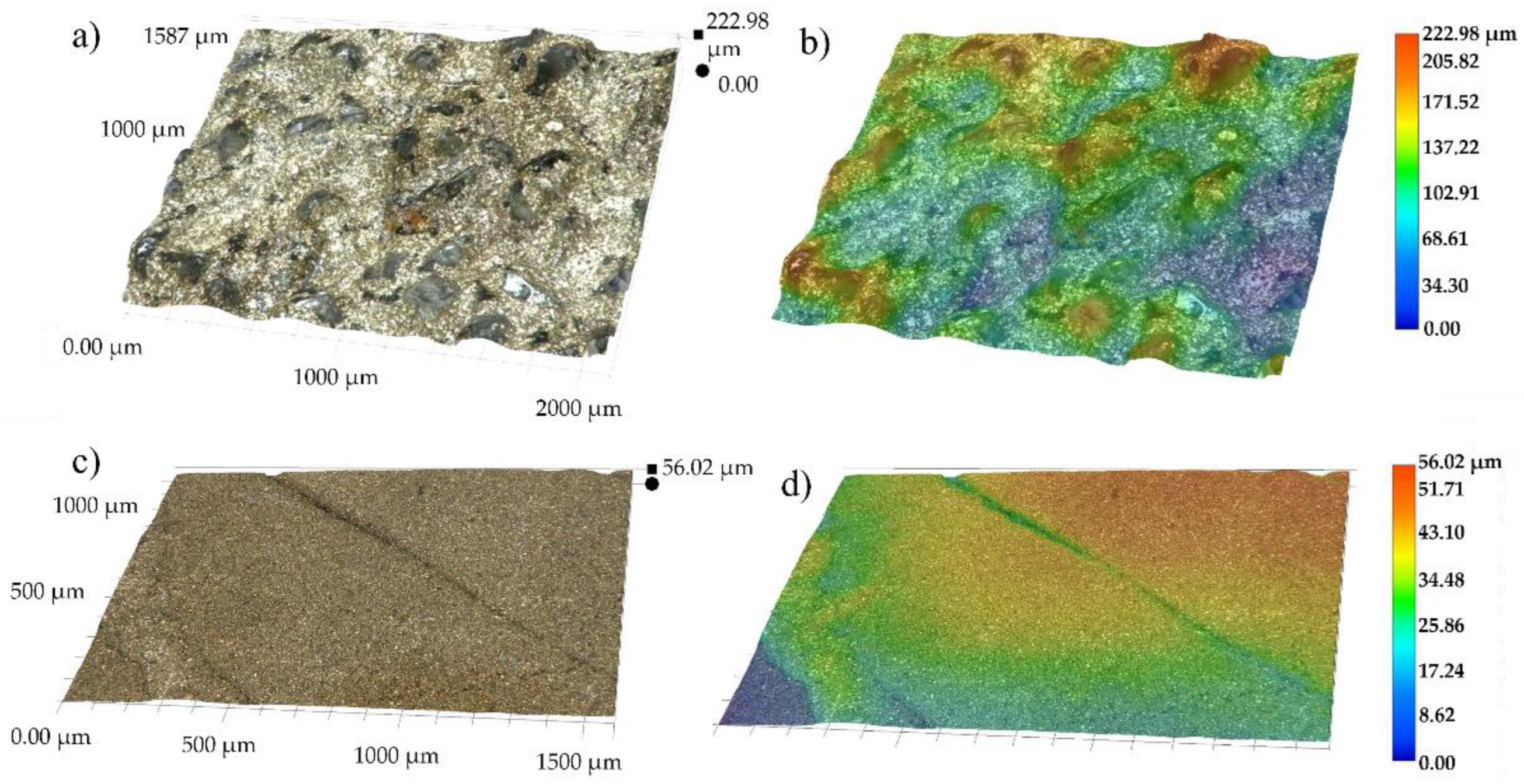
| Cr | Ni | Mo | Mn | Si | P | C | Fe | |
|---|---|---|---|---|---|---|---|---|
| 316L filament | 17.0 | 10.2 | 2.2 | 1.58 | 0.8 | 0.03 | 0.018 | Balance |
| Avrami Exponent (n) | Nucleation Rate (K) | |
|---|---|---|
| Refractory ballast sintered | 0.5788225 | 0.2642992 |
| Vacuum sintered | 0.5063679 | 0.3019814 |
| Austenitic γ | Ferrite δ | |
|---|---|---|
| Refractory (30 s) | 86.92% | 13.07% |
| Refractory (60 s) | 96.33% | 3.66% |
| Refractory (240 s) | 95.89% | 4.10% |
| Vacuum (30 s) | 98.57% | 1.42% |
| Vacuum (60 s) | 99.03% | 0.96% |
| Vacuum (360 s) | 99.18% | 0.81% |
| Cr | Ni | Mo | Mn | Si | C | Fe | |
|---|---|---|---|---|---|---|---|
| Refractory (240 s) | 13.13 | 11.09 | 1.29 | 0.38 | 0.30 | 2.87 | Balance |
| Vacuum (360 s) | 12.69 | 11.63 | 1.23 | 0.52 | 0.14 | 2.73 | Balance |
| DIN 17440 | 16.0–18.0 | 10.0–14.0 | 2.0–3.0 | 0.0–2.0 | 0.0–1.0 | 0.0–0.03 | Balance |
| Cr | Ni | Mo | Mn | Si | C | O | Al | Fe | |
|---|---|---|---|---|---|---|---|---|---|
| Refractory (240 s), voids | 4.82 | 0.91 | 0.17 | 2.34 | 5.52 | 6.18 | 40.73 | 28.42 | Balance |
Disclaimer/Publisher’s Note: The statements, opinions and data contained in all publications are solely those of the individual author(s) and contributor(s) and not of MDPI and/or the editor(s). MDPI and/or the editor(s) disclaim responsibility for any injury to people or property resulting from any ideas, methods, instructions or products referred to in the content. |
© 2023 by the authors. Licensee MDPI, Basel, Switzerland. This article is an open access article distributed under the terms and conditions of the Creative Commons Attribution (CC BY) license (https://creativecommons.org/licenses/by/4.0/).
Share and Cite
Ortega Varela de Seijas, M.; Bardenhagen, A.; Rohr, T.; Stoll, E. Indirect Induction Sintering of Metal Parts Produced through Material Extrusion Additive Manufacturing. Materials 2023, 16, 885. https://doi.org/10.3390/ma16020885
Ortega Varela de Seijas M, Bardenhagen A, Rohr T, Stoll E. Indirect Induction Sintering of Metal Parts Produced through Material Extrusion Additive Manufacturing. Materials. 2023; 16(2):885. https://doi.org/10.3390/ma16020885
Chicago/Turabian StyleOrtega Varela de Seijas, Manuel, Andreas Bardenhagen, Thomas Rohr, and Enrico Stoll. 2023. "Indirect Induction Sintering of Metal Parts Produced through Material Extrusion Additive Manufacturing" Materials 16, no. 2: 885. https://doi.org/10.3390/ma16020885
APA StyleOrtega Varela de Seijas, M., Bardenhagen, A., Rohr, T., & Stoll, E. (2023). Indirect Induction Sintering of Metal Parts Produced through Material Extrusion Additive Manufacturing. Materials, 16(2), 885. https://doi.org/10.3390/ma16020885






